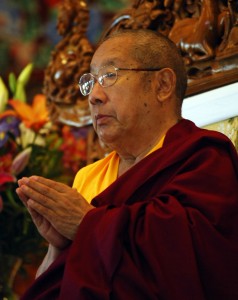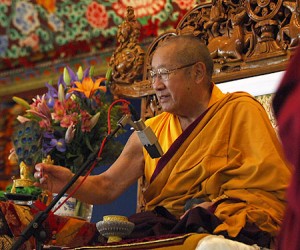The following is an excerpt from a teaching by His Holiness Penor Rinpoche called “Guru Yoga” reprinted here with permission from Palyul Ling International
The teachings we know of as Buddhism were first taught by the Buddha Sakyamuni. These teachings have been maintained by a lineage of living transmission up to the present day by those who have been inspired to follow the example of the Buddha and to study that path and transmit it to others. In any of the various Buddhist traditions we find that there are countless numbers of people who through their study and contemplation have become extremely learned and gifted with spiritual power and realization. But the reason why they teach and the reason why these individuals undertake to become learned in the dharma should not be to indulge in self-aggrandizement. One does not become learned in dharma in order to think of oneself as learned and to gain some special status. One does not teach others from a sense of personal pride, either. Dharma is maintained because it brings benefit to those who hear the teachings. That is the motivation behind teaching.
In order to become an authentic teacher of the tradition, it is not sufficient to simply read enough books to become very clever at the teachings and then set oneself up as a teacher. Rather, it is the case that one’s own teacher, a particularly realized individual, must give one permission to teach. It may also be the case that one will be graced with a vision of one’s chosen deity during which experience the deity will confer upon one the blessing and authority to teach.
So it isn’t simply a question of ordinary people developing enough cleverness to be able to talk well about the dharma. The true benefit of the teachings doesn’t come about through an ordinary approach, because that more ordinary approach tends only to feed one’s own pride and conflicting emotions. No benefit that can come out of that. It is only when the teaching is a selfless gesture to benefit others based upon an authentic transmission that we really have the benefit that is necessary for the dharma to be maintained.
If we take into account all of the teachings of the Buddha, including all of the commentaries on those teachings by the great mahasiddhas – the learned pundits of the Indian, Tibetan and other traditions of Buddhism – it would be impossible for a single individual to try and put all of that into practice. This does not mean that there is any aspect of those teachings that are useless and have no function. The Buddha Sakyamuni turned the wheel of the dharma in three successive transmissions during his time in the world. In vajrayana when we consider the thousands of volumes that collectively known as the buddha dharma, including the 84,000 collections of the Buddha’s teachings and the 6,400,000 texts of tantra, it is obvious that no single person could absorb and practice all of that.

